The emperor has no political power, yet he enjoys a unique place in Japanese society, notes Dr Rajaram Panda.
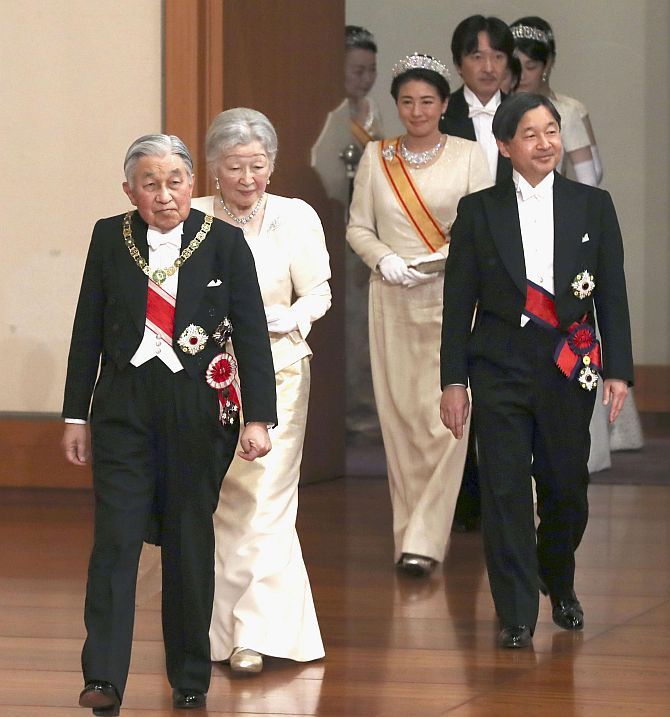
The much-awaited moment heralding the opening of a new chapter in Japan's history came in the morning of April 1, 2019 when Chief Cabinet Secretary Yoshihide Suga announced the new imperial era to be named 'Reiwa'.
The process of announcing the new era name, or gengo, in just two hours, a relatively short period of time, was aimed to prevent the new era name being leaked by people involved ahead of the official announcement.
With this, the final steps towards initiating the nation's first imperial succession in three decades were completed ahead of Emperor Akihito's abdication.
The new era name is based on a poem from Manyoshu, the oldest existing anthology of Japanese poetry.
Written in two kanji/em>s, the first character of Reiwa represents 'fortunate', while the second can be translated as 'peace or harmony'.
This was the first time that the characters were taken from Japanese classical literature.
Previous era names had used kanjis from Chinese literature.
The poem in question described an ume Japanese apricot flower in full bloom in early spring after surviving a cold winter.
The new era will start on May 1, when Crown Prince Naruhito ascends to the Chrysanthemum Throne following his father Emperor Akihito's abdication a day earlier.
The arrival of Reiwa will in turn end a 30-year run of the Heisei (achieving peace) Era, which began in January 8, 1989.
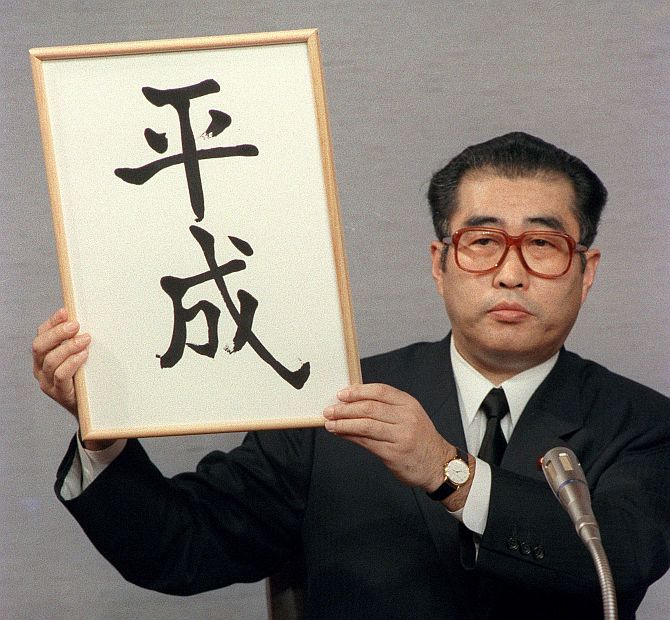
Japan is the only country in the world that uses the era name system, which has its roots in China, though the Gregorian calendar is also in common use.
The country has adopted almost 250 eras since the seventh century.
In the past, emperors would change era names mid-reign to foster a spirit of renewal after natural disasters or crises; more recently, a single era has been used to mark the entirety of a monarch's reign.
Other countries have kings and queens, but Japan is the only country that has an emperor and the imperial system.
The institution is heavily protected for all these centuries, though the divinity status was surrendered by Showa Emperor Hirohito after Japan's defeat in World War II.
The emperor remains a symbol of the country and has not exercised any political rights since the Showa emperor's decision to announce Japan's surrender in 1945.
The naming of the new era -- Reiwa -- is only for the third time in almost a century.
For a country such as Japan with long history of an imperial system, the era name carries enormous significance.
The new era name carrying two kanji characters must be easy to read and write and not be in common use and therefore the process of choosing is long as the name sets tone for the new emperor's reign.
The era name is closely associated with important domestic and national events.
While the Meiji era (enlightened rule) that started with the Meiji Restoration in 1868 and ended in 1912 with the emperor's death is remembered as a period of Western-inspired modernisation, the Taisho era was short-lived when the emperor died in 1926 ushering the Showa era (enlightened harmony).
The Showa era was one of the longest in Japanese history, ending in 1989 when Showa Emperor Hirohito died.
The Showa era was closely associated with Japan's rapid economic development, the rise of militarism and his role in World War II, with the emperor exercising his political rights to bring the war to an end by announcing Japan's surrender.

The three decades of Heisei evoke similarly ambivalent feelings: It saw the end of the bubble economy and deteriorating relations with China.
The tumultuous three decades are sometimes referred to as the 'era of natural disasters'.
The period also saw the eruption of Mount Unzen's Fugen Peak in 1991 and two major earthquakes -- the Great Hanshin Earthquake of 1995 that destroyed the city of Kobe and the Great East Japan Earthquake of March 2011.
The latter triggered a deadly tsunami and the most frightening nuclear crisis at the Fukushima nuclear power plant since Chernobyl in 1986.
Many will also forever associate the era with the sarin gas attack on the Tokyo subway system in 1995 -- the worst act of terrorism in modern Japanese history -- and several notorious crimes involving serial killings and mass murders.
The choice of era name has a long process.
After months of secret deliberations, with the final choice known to a select group of experts and senior politicians, the government chose the kanji characters because they signify, as explained by Prime Minister Shinzo Abe, 'a culture being born and nurtured by people coming together beautifully'.
The nine-member panel chosen to select the new era name included Nobel Prize-winning stem cell scientist Shinya Yamanaka and award-winning novelist Mariko Hatashi and agreed on a name from about five options put forward by scholars of classical Chinese and Japanese literature.
Manyoshu was compiled more than 1,200 years ago and it contained poems by people of various social status, including emperors, noblemen and noblewomen, warriors and ordinary farmers.
By choosing the new gengo (era name), the government hopes it will be widely accepted by the people.
Japan has had nearly 250 eras since adopting the system in the 7th century.
Reiwa will be the 248th in the history of Japan, which has used the Chinese-style calendar system since 645.
In modern times, each era has run the length of an emperor's reign.
The names of past four predecessor eras -- Heisei, Showa, Taisho and Meiji -- were announced after the natural death of the emperor on the throne.
This is the first time the new era name was made public while the reigning emperor is alive.
The background to this unusual situation dates back to August 2016, when in a rare address to the nation, Emperor Akihito hinted at his desire to abdicate due to his advanced age, as opposed to his immediate predecessors who reigned until their deaths.
Respecting the emperor's desire, the government plunged into action on how to facilitate Emperor Akihito's abdication.
In 2017, the Diet enacted one-off legislation to enable him to abdicate, making him to be the first by a sitting Japanese monarch to do so in around 200 years.
The impending end of the Heisei period was reportedly a factor in the government's decision to implement death sentences in 2018 against 13 members of the Aum cult behind the 1995 sarin attack.
All 13 executions were carried out in July.
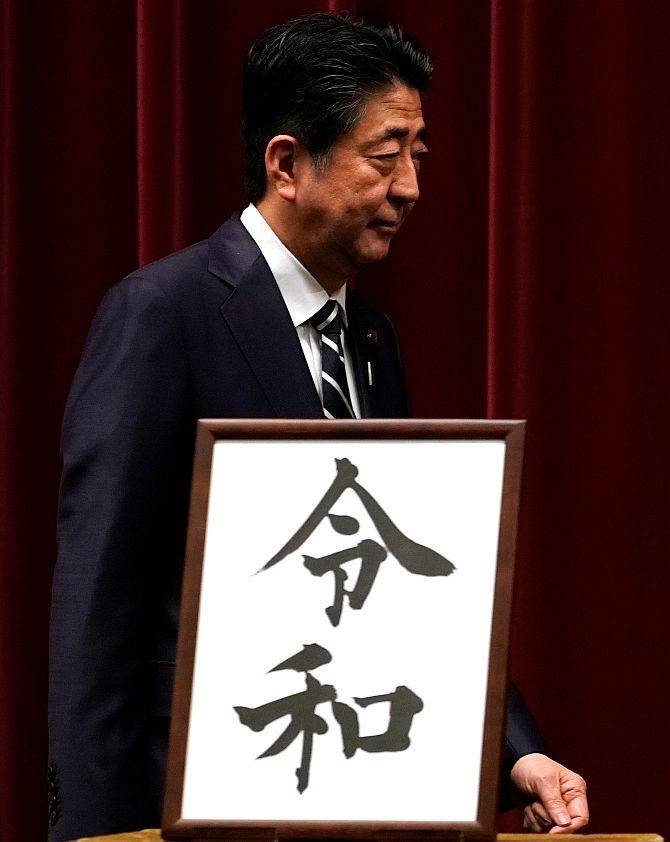
The change in era name is a significant event in Japan.
Gengo plays an integral role -- both practically and psychologically -- to the lives of the Japanese people.
Gengo has long been cherished in Japan as a way of identifying a year.
For example, Heisei 31 would correspond to 2019 and a person's age is calculated as per the year the new era began.
Besides, in many official documents, computer systems, its change would have far-reaching practical implications.
Local municipality officials, computer engineers and calendar manufacturers, etc have spent months preparing for necessary changes.
Care was taken that the new name must not start with the first letter of any of the last four eras: Heisei, Showa, Taisho and Meiji.
While choosing Heisei, three names were considered: Shubun, Seika and Heisei, before finally choosing Heisei.
Others are waiting to submit marriage certificates or filing other official registration until the new era starts.
Hanko manufacturers see a bonanza with the new era as demands for new Hankos will skyrocket.
Hankos are private ink seals, commonly used in Japan to sign official documents.
Manufacturers of hanko expect to benefit.
Many manufacturers have already received advance orders.
Financial traders pin their hopes on the new era name to bolster a shaky market.
Still others are waiting for the 'golden week' lasting for 10 days from May 1, a real boost to tourism and recreation ventures.
The significance of era names in Japan can be gauged from the fact that it has a sense of defining a period.
A country that beautifully combines tradition with modernity as is reflected in every aspects of Japanese life and culture is something unique that one needs to observe closely to appreciate.
This is what distinguishes Japan from other societies.
There is a sense of beauty in everything is done and practised in Japan.
Choosing the era name is one such exercise.
Therefore, the new gengo provides an opportunity for the Japanese to put the past three decades of the Heisei era into context.
Though most nations around the world have certain rituals and belonging as well as nationalism to define their identity, for the Japanese the emperor as a symbol of who the Japanese are as a people enjoys a special status.
In particular, the symbolism attached to the emperor assumes greater importance in troubled times, as the world faces today.
On January 7, 1989 when the era name was changed after Emperor Hirohito's death, posthumously known as Emperor Showa, then chief cabinet secretary Keizo Obuchi, who later became prime minister, held up a calligraphy work showing the two Chinese characters making up the name Heisei.
He then read out then prime minister Noburo Takeshita's statement.
This time, Prime Minister Abe made the statement directly to the people, conveying the meaning of the new gengo.
The government will now notify 195 countries as well as international organisations of the decision through diplomatic missions at home and abroad and other means.
Prior to the Meiji Restoration of 1868, when era names were formalised and designated to a single reign, emperors frequently changed them, often after natural disasters and other inauspicious events.
For example, Emperor Komei, the predecessor to the Meiji emperor and the current emperor's great-great-grandfather, oversaw seven era names during his time on the throne.
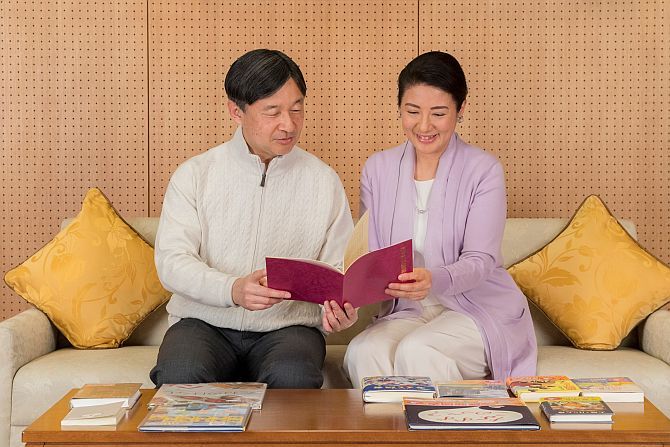
When Emperor Akihito lacked a grandson, the Japanese government in 1997, then headed by Ryutaro Hashimoto, considered secretly allowing empresses to reign.
Officially a debate started on the issue under a panel of experts in 2005.
The experts called on the government to 'swiftly start considering' changing the law to allow women and their descendants to ascend the throne.
Crown Prince Naruhito, soon to become Japan's 126th emperor and also Japan's first emperor born after World War II, has only a daughter.
Princess Akio created a debate on whether or not a woman could ascend the throne to become the empress of Japan due to being the only child of the first in line to the throne.
Sadly, such talk of allowing an empress was dropped the moment Akio's male cousin was born.
Though the plan was later dropped, the government of Junichiro Koizumi who served between 2001 and 2006 had leaned towards revising imperial house law, which allows only male heirs who have emperors on their father's side to reign.
Koizumi launched an advisory panel on the issue.
The panel proposed in 2005 that female monarchs be allowed, in a bid to avoid an expected succession crisis for the world's oldest hereditary monarchy.
When Prince Hisahito was born to Crown Prince Akishino and Princess Kiko, the imperial family's first male in 41 years, Koizumi's plan fizzled out.
There are currently 18 imperial family members and 13 of them are women.
After the crown prince ascends the Chrysanthemum Throne, there will be only three male heirs -- the crown prince's younger brother Prince Akishino, 53, Prince Hisahito, 12, and Prince Hitachi, 83, Emperor Akihito's younger brother.
The Japanese government and the people of the country are concerned about the dwindling number of imperial family members.
The 1947 imperial house law stipulates that only men can succeed to the throne, and requires women to abandon their Imperial status after marrying commoners.
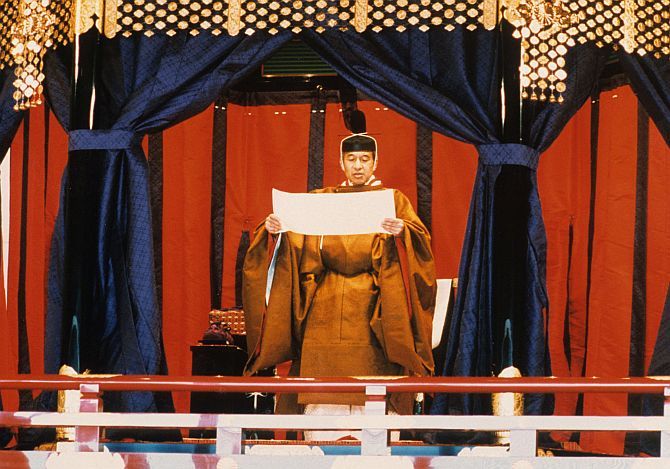
Unlike former emperors, Emperor Akihito has been different in many ways.
He decided to abdicate owing to failing health, the first in 200 years to do so.
He was the first to marry a commoner, the first to raise their children at home instead of sending them away, and the first emperor to have been stripped of political power under Japan's post-war constitution.
Akihito is truly an emperor of firsts, and his achievements will certainly be a hard act to follow.
As a young boy, he saw the devastation of the war and resolved to work for peace once he ascended the throne.
As a man, Akihito had to watch his father cling to the throne despite numerous health issues that brought the country to a virtual standstill.
It was through these experiences that Akihito was able to understand both the importance of taking on his role and knowing when to step down.
He and his wife had made it their life's mission to mend the broken bonds between Japan and the rest of the world, which many people believe they have during his reign.
Unlike Queen Elizabeth of England, the emperor does not enjoy much power; he is simply the head of the imperial family and the State of Japan.
He is meant to unite the people of Japan, and stand as a symbol of the State.
He is allowed to live in the Tokyo Imperial Palace with his family and has only ceremonial powers.
Emperor Hirohito relinquished his divinity status after Japan's surrenders and emperors no longer enjoyed any power in terms of running the country.
With Emperor Akihito's abdication, Prince Fumihito Akshino will become the first in line to the throne in the event of Naruhito's passing.
His wife Kiko will become Crown Princess Kiko and their son Hisahito will become Prince Hisahito and second in line to the throne.
Both soon-to-be Emperor Naruhito and his brother have at least one daughter -- Prince Fumihito has two older daughters -- which has begun to start a talk in Japanese government about whether or not the title of empress of Japan would be viable in the future due to the abundance of female heirs and lack of multiple male heirs.

Crown Princess Masako shall be the new empress.
She is well-travelled and has lived in numerous countries, passed the Japanese ministry of foreign affairs entrance examination with 27 other applicants out of 800.
As a former diplomat, Crown Princess Masako has conducted herself with dignity and grace.
She has stayed out of the public eye because of the pressure from the imperial household for her to give birth to a male heir and her desire to pursue the life of a diplomat without being able to engage in political activities due to her position.
Many hope that she will make a good empress and support her husband and her country as best she can.
Since Emperor Akihito's abdication is set to occur on April 30, 2019 and Crown Prince Naruhito ascends the throne the following day, this means that the calendar year of 2019 will actually be split between Heisei 31 and the new era Reiwa starting on May 1.
Interesting times are ahead for the Japanese people as they start accepting and rejoicing the new gengo.
Once Naruhito ascends the throne as the country's 126th Emperor on May 1, the gengo will appear on everything from train tickets and software to official documents and calendars.
Dr Rajaram Panda is a Lok Sabha Research Fellow, Parliament of India. The views expressed are personal.










